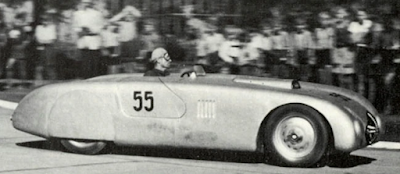In the wreckage of Germany in the years immediately after WWII, BMW alumni Ernst Loof, George Meier and Lorenz Dietrich cooked up a scheme to manufacture and sell racing cars. This does not look like a good business plan in retrospect; it must have seemed even crazier in 1947, when much of Europe was involved in a daily struggle just to put food on the table. If there was any kind of export market, it wasn't in most countries the Nazis had invaded, and German cars were not exactly making inroads into the US market either (VW finally sold two Beetles there in 1949). Then there was the problem of sourcing an engine; recovery from the comprehensive wartime bombings hadn't yet happened. So the partners came up with the idea of scavenging pre-war BMW 328s for their engines, rebuilding them, and fitting them into a new, lightweight tubular chassis sheathed in alloy bodywork. Amazingly, there were some takers, and Karl Kling won the German 2 liter championship in 1947 with the first car...
Kling's car, shown above, looked a lot like the 1941 Berlin-Rome 328 below, bodied by Carrozzeria Touring for a planned race between the two cities. Plans for the race were shelved as Hitler's war plunged Europe into darkness. The simple envelope body forms, tiny door openings and skirted rear wheels are similar on Veritas #1 to the Touring-bodied 328. At a casual glance the only big difference is the twin-kidney BMW grille on the Berlin-Rome car.
Soon enough Veritas was building touring-oriented versions of the cars, like the Saturn coupe and Scorpion cabriolet, still with the scavenged pre-war BMW engines. Bodies on these cars were built by Spohn, which had built some of the Maybach Zeppelins from the Thirties...
Veritas customers had other success with the cars as the Forties wore on, but problems emerged for the Veritas company as the decade ended. First of all, the supply of rebuildable, used BMW engines dried up. And BMW, which would only get back to producing the inline 6 for its 501 (along with the 502 V8) in autumn of 1952, over 7 years after war ended, decided it didn't want the Veritas firm to call its cars Veritas BMWs. Perhaps BMW management viewed the Veritas as a glorified used car...
So Veritas adopted another inline six, this time a single overhead cam design engineered by Eric Zipprich. Displacement was right under the two-liter limit at 1,998 cc, and the engines were produced in small numbers by Heinkel. Veritas manufacturing moved to a larger headquarters in 1949, but fragile finances prevented filling the dozens of advance orders for the new car.
The new Veritas engine initially proved less reliable than the old BMW unit, and the financially-strapped company soon ran out of maneuvering room...
So Veritas went bankrupt at the end of 1950. Dietrich launched the enterprise of making Dyna Veritas cars based upon the French Panhard twin-cylinder cars. The German bodywork was more attractive than the original postwar Panhard bodies...
Meanwhile, Ernst Loof reorganized the sports car operation and moved it into some abandoned pits at the Nurburgring track. Veritas then built its final cars, mostly with more de luxe coachwork than the early BMW specials.
These cars were offered in short and long chassis form. The coupe above is a K3, for short chassis (kurz) and 3-passenger configuration. There were also cabriolets like the car shown below. The full-width bodywork on these last coupes and cabrios avoids a slab-sided appearance by featuring a dip in the fender line ahead of the rear wheels. It's a more restrained approach than the vents, portholes and surface trim that adorned some of the early 328-engined cars.
There was at least one futuristic competition spider built, appearing near the end of production at the Nurburgring facility, which closed after 1952. The lines predict the shape of the later Borgward RS* racers.
Though this car has survived, no photos of the engine have appeared, so it's not clear whether it now has the Heinkel-built engine or a BMW unit.
From 1951 to 1953, the year the of this competition spider, about 20 of the Nurburgring cars had been built including racers. Of the earlier BMW-based cars, it has been estimated that over 5 dozen were produced. After the supply of the Heinkel-built 2 liter six ran out, Ford and Opel engines were used to power a few cars. Ernst Loof would later assist BMW with their new product program, including a 2-seater prototype that eventually became the 507. But that's a story for another day...
*Footnote: The Borgward racers are described in the post for March 3, 2017, entitled "Forgotten Classic: When Borgward Went Racing."
Photo Credits:
Top: automobilefandom.com
2nd: sleepingbeauties.com.au
3rd &. 4th: carcatalogue.com
5th thru 10th + 12th: de.wikipedia.org
11th: ritzsite.nl
13th thru 15th: motorbase.com
Photo Credits:
Top: automobilefandom.com
2nd: sleepingbeauties.com.au
3rd &. 4th: carcatalogue.com
5th thru 10th + 12th: de.wikipedia.org
11th: ritzsite.nl
13th thru 15th: motorbase.com














No comments:
Post a Comment